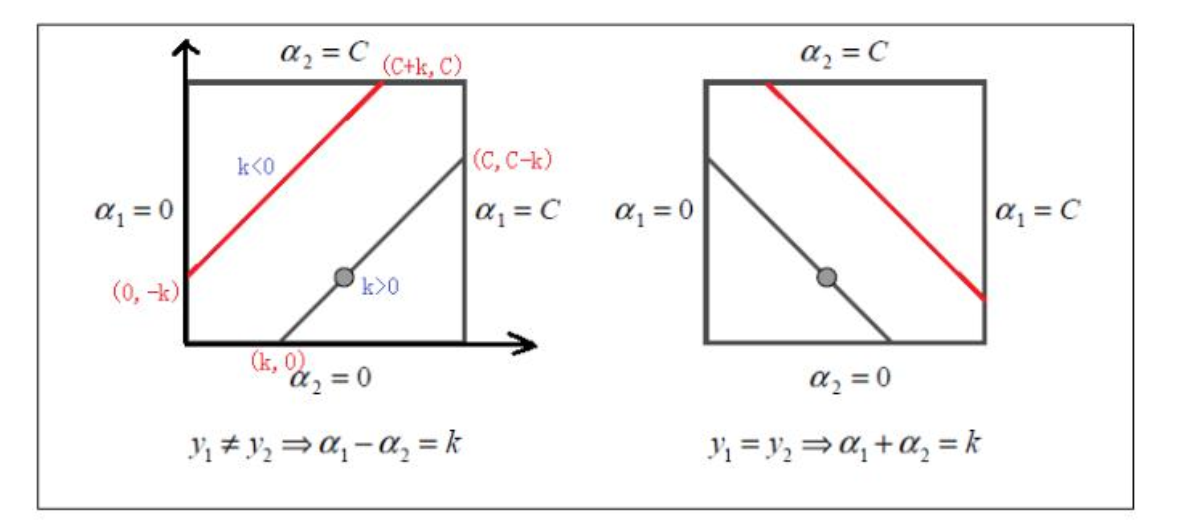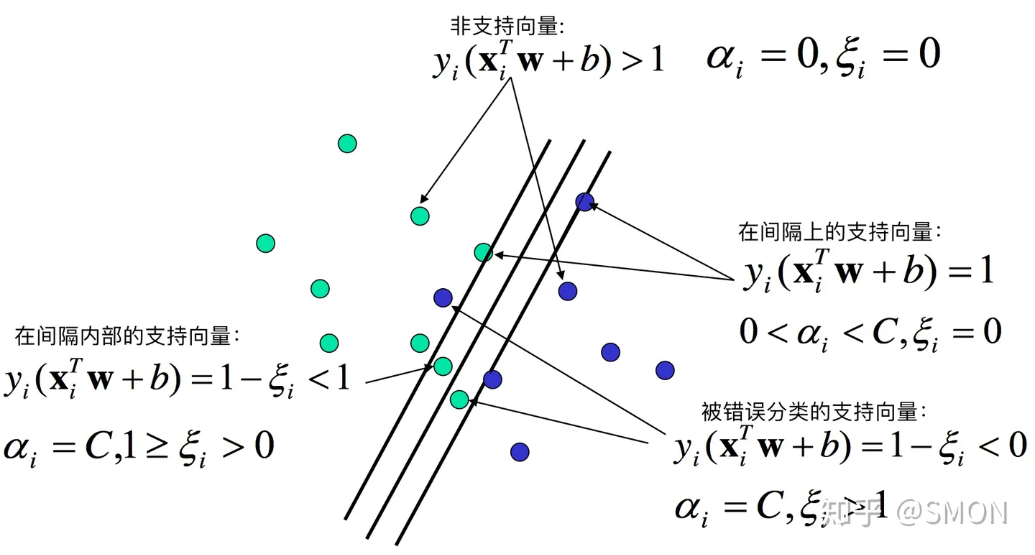1. alpha2 的修剪

if y1 != y2 :
α1 - α2 = k # 不用算k的具体大小
if k > 0: # 上图的左 下这条线
α2 的区间 (0, c-k)
k < 0 : # 上图的左 下这条线
α2 的区间 (-k, C)
所以:
L = max(0, -k) # k>0 还是<0 都统一表达了
H = min(c, c-k)
else:
y1 = y2 右边的图 同理
2.参考
参考:https://zhuanlan.zhihu.com/p/49331510

非支撑向量:
alpha=0

间隔上的支撑向量:
0<alpha<c

间隔之内:
alpha=c and 0< ei <1

上面的三种都是正确分类的;
错误分类的:

alpha=c and ei > 1
yi(wxi+b) = 1-ei < 0 使负的 预测的与实际的符号相反
3. 代码实现
"""
算法思想:
创建一个alpha向量 并初始化为0
当迭代次数小于 最大迭代次数(外层循环):
遍历α中的每一个αi(内层循环):
如果该αi可以被优化:
随机选择另一个αj
同时优化 αi aj
如果αi aj优化完毕退出内层循环
"""
import numpy
import numpy as np
import random
import matplotlib.pyplot as plt
def load_data(filename):
X = []
y = []
fr = open(filename)
for line in fr.readlines():
x1, x2, y_true = line.strip().split("\t")
X.append([float(x1), float(x2)])
y.append(float(y_true))
fr.close()
return numpy.array(X), np.array(y)
def show_data(filename, line=None):
X, y = load_data("./testSet.txt")
class_1_index = np.where(y == -1) # -1 负样本的索引
X_class_1 = X[class_1_index, :].reshape(-1, 2) # 负样本对应的X取出
class_2_index = np.where(y == 1) # +1 正样本的索引
X_class_2 = X[class_2_index, :].reshape(-1, 2) # 正样本对应的X取出
fig = plt.figure()
ax = fig.add_subplot(1, 1, 1)
ax.scatter(X_class_1[:, 0], X_class_1[:, 1], c="r", label="$-1$")
ax.scatter(X_class_2[:, 0], X_class_2[:, 1], c="g", label="$+1$")
plt.legend()
if line is not None:
alphas, b = line
x = np.linspace(1, 8, 50)
w = np.sum(alphas*y[:, np.newaxis]*X, axis=0)
# w1*x1 + w2*x2 +b = 0 # 或者 +1 -1
y = np.array([(-b - w[0]*x[i]) / w[1]for i in range(50)])
y1 = np.array([(1 -b - w[0]*x[i]) / w[1]for i in range(50)])
y2 = np.array([(-1 -b - w[0]*x[i]) / w[1]for i in range(50)])
ax.plot(x, y, "b-")
ax.plot(x, y1, "b--")
ax.plot(x, y2, "b--")
plt.show()
def smo_simple(dataArr, yArr, C, toler, maxIter):
numSample, numDim = dataArr.shape # 100行 2列
# 初始化
b = 0
alphas = np.zeros((numSample, 1))
iterations = 0 # 迭代次数
while iterations < maxIter:
alphaPairsChanged = 0
for i in range(numSample):
# 针对对i个样本给出预测值 这里没有使用核函数变换
# fXi= wXi+b
# alphas * y * X * Xi +b Xi为一条样本
fXi = np.sum(alphas * yArr[:, np.newaxis] * dataArr * dataArr[i, :]) + b
# Ei 为误差
Ei = fXi - yArr[i]
"""
kkt 约束条件:
yi*(wXi+b) >= 1 且alpha=0 远离边界 正常分类的 ----条件1
yi*(wXi+b) = 1 且0<alpha<c 边界上面
yi*(wXi+b) < 1 且 alpha=c 两条边界之间 ----条件2
# 0 <= alphas[i] <= C 已经在边界上的 alpha不能再优化
Ei = fXi - yArr[i] 两边都 乘以 yArr[i]
yArr[i]*Ei = yArr[i]*fXi - 1 # 偏差
如果 yArr[i]*Ei < -toler alpha应该为C 如果<C 就需要优化 ----对应条件2
如果 yArr[i]*Ei > toler alpha应该为0 如果>0 就需要优化 ----对应条件1
"""
if ( (yArr[i]*Ei < -toler) and (alphas[i] < C) ) or ( (yArr[i]*Ei > toler) and (alphas[i] > 0)):
# 进入这里 说明需要优化alpha[i] 我们在随机取一条alpha[j] j!=i
j = selectJrand(i, numSample)
fXj = np.sum(alphas * yArr[:, np.newaxis] * dataArr * dataArr[j, :]) + b
Ej = fXj - yArr[j]
# 先复制一份old alphaI alphaJ
alphaIold = alphas[i].copy()
alphaJold = alphas[j].copy()
# 根据 yArr[i] yArr[j] 是否同号 计算 L H
if yArr[i] != yArr[j]:
L = max(0, alphas[j] - alphas[i])
H = min(C, C + alphas[j] - alphas[i])
else:
L = max(0, alphas[j] + alphas[i] - C)
H = min(C, alphas[j] + alphas[i])
if L == H:
print("L == H")
continue
# 计算 eta, eta是alpha[j]的最大修正量 eta == 0 则 continue
# eta = K(1,1)+K(2,2) - 2K(1,2)
eta = (np.sum(dataArr[i,:] * dataArr[i, :]) +
np.sum(dataArr[j, :] * dataArr[j, :]) -
2 * np.sum(dataArr[i,:] * dataArr[j, :]))
if eta == 0:
continue
# 计算新的alphas[j]
alphas[j] = alphaJold + yArr[j]*(Ei - Ej) / eta
# 修剪新的alphas[j]
alphas[j] = clipAlpha(alphas[j], H, L)
# 新的alphas[j] 与 alphaJold 如果改动量很小 则 contine 退出
if abs(alphaJold - alphas[j]) < 0.00001:
continue
# 更新 alphas[i]
alphas[i] = alphaIold + yArr[i] * yArr[j] * (alphaJold - alphas[j])
# 计算参数b
bi = b - Ei - yArr[i] * (alphas[i] - alphaIold) * np.sum(dataArr[i, :] * dataArr[i, :]) - \
yArr[j] * (alphas[j] - alphaJold) * np.sum(dataArr[i, :] * dataArr[j, :])
bj = b - Ej - yArr[i] * (alphas[i] - alphaIold) * np.sum(dataArr[i, :] * dataArr[j, :]) - \
yArr[j] * (alphas[j] - alphaJold) * np.sum(dataArr[j, :] * dataArr[j, :])
if 0<alphas[i]<C:
b = bi
elif 0<alphas[j]<C:
b = bj
else:
b = (bi+bj)/2
# 走到这里说明 alpha b 更新了
alphaPairsChanged += 1
# 输出
print(f"iter: {iterations}, i: {i}, pairs changed: {alphaPairsChanged}")
if alphaPairsChanged ==0:
iterations += 1
else:
iterations =0
return b, alphas
def selectJrand(i, numSample):
j = i
while j == i:
j = int(random.uniform(0, numSample))
return j
def clipAlpha(aj, H, L):
if aj > H:
return H
if aj < L:
return L
return aj
if __name__ == '__main__':
X, y = load_data("./testSet.txt")
C = 0.6
toler = 0.001
maxIter = 40
b, alphas = smo_simple(X, y, C, toler, maxIter)
print(b)
print(alphas)
show_data("./testSet.txt", line=(alphas, b))
